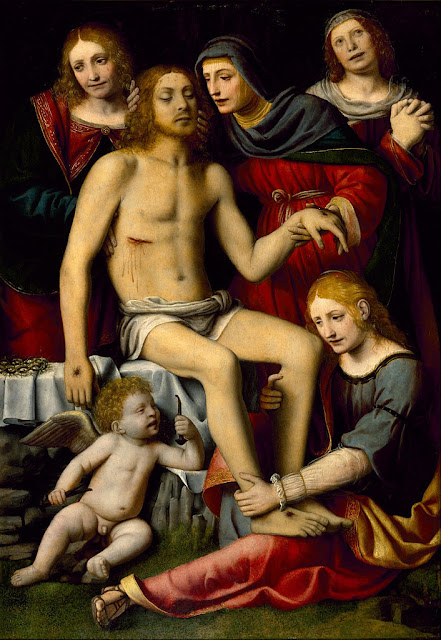 |
| Filippo Lippi Pietà ca. 1435-40 oil on panel Museo Poldi Pezzoli, Milan |
 |
| Giovanni Bellini Imago Pietatis ca. 1460-70 oil on panel Museo Poldi Pezzoli, Milan |
PIETY ABOVE ALL ELSE IS NECESSARY FOR THE PAINTER
Colors are like words: once the eyes see them they sink into the mind just as do words heard by the ears. Correspondingly, making an initial sketch of a subject to be painted is like formulating the preliminary thoughts and arguments in a speech. This explains why the common, uneducated multitude can comprehend the language and discourse of painting. It has just as much influence among wise men, too. As Gregory of Nyssa rightly put it, painting speaks silently, and with its aid the walls of a church become blooming meadows. Just as an orator performs his duty best if he speaks with the passion and energy needed to move people's minds, so too it is the great charge of painting – assuming that the colors and designs are right – to implant in the mind feelings of reverence, fear, and sadness whenever demanded by the subject. . . . In order to stir up their own passions, the ancient poets used to wander through groves, valleys, mountains, and seashores while hunting for those psychological impulses. They even went right into caves and dark caverns, as the tragedian Euripides was said to have done. Thinking that any other dwelling would be too cheerful for him, he hid himself in a cave so that he might amass for himself collected feelings of melancholy, assorted kinds of fears, disquieting visions, and frightful misfortunes. Famous sculptors mentally prepared themselves by fasting and living in poverty so they could get themselves into the right state of mind. I have no doubt that the three artists who sculpted the celebrated Laocoön – a work so expressive of his sorrows – were like tragic poets sustained by a diet consisting solely of lupine seeds. Pliny reports that this hardy nourishment had been instrumental in the creation of great works of art."
– from Sacred Painting, a treatise composed in Latin by Cardinal Federico Borromeo in 1624, translated by Kenneth S. Rothwell, Jr. in 2010 for I Tatti Renaissance Library and published by Harvard University Press
 |
| Bernardino Luini Lamentation over the dead Christ ca. 1509-23 oil on panel Museum of Fine Arts, Houston |
 |
| Jan van Scorel Lamentation with Donor ca. 1535 oil on panel Centraal Museum, Utrecht |
 |
| Hans Baldung The Trinity and Mystic Pietà before 1545 oil on panel National Gallery, London |
 |
| Agnolo Bronzino Lamentation Altarpiece for Chapel of Eleonora of Toledo 1553 oil on panel Palazzo Vecchio, Florence |
 |
| Antonis Mor Crucifixion 1573 oil on canvas National Sculpture Museum, Valladolid |
 |
| Paolo Veronese Dead Christ supported by Angel and adored by a Franciscan ca. 1584-89 oil on canvas Museum of Fine Arts, Houston |
 |
| Lambert Sustris Pietà with Angels before 1591 oil on canvas Musei di Strada Nuova, Genoa |
 |
| Cigoli Pietà with St John the Evangelist and the Magdalene ca. 1599-1600 oil on panel Fondazione Musei Senesi |
 |
| Annibale Carracci Pietà before 1605 oil on canvas Dulwich Picture Gallery, London |
 |
| Giulio Cesare Procaccini Descent from the Cross with Mary Magdalene, St Augustine, and St Jerome ca. 1618 oil on canvas Art Gallery of New South Wales, Sydney |
 |
| Giovanni Andrea Ansaldo Deposition ca. 1630 oil on canvas Accademia ligustica di Belle Arti, Genoa |
 |
| Luca Giordano Descent from the Cross ca. 1659 oil on canvas Museo de Santa Cruz, Toledo, Spain |